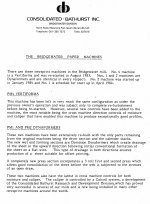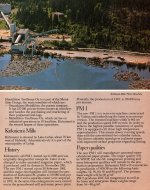You are using an out of date browser. It may not display this or other websites correctly.
You should upgrade or use an alternative browser.
You should upgrade or use an alternative browser.
Dot gain is difference on Perfecting press
- Thread starter sornchai
- Start date
SteveSuffRIT
Well-known member
The front side and back side of a perfecting press may print differently. If within 3% of each other, I would treat them as being the same.
You could create separate curves for each, or use an average of both as a compromise.
You could create separate curves for each, or use an average of both as a compromise.
gordo
Well-known member
How to make compensation plate Curves? I used prinect workflow
Here are the principles: The principle of dot gain compensation plate curves
Heidelberg may want you to apply a (unnecessary) linearizing curve to the plate before you apply a dot gain compensation curve.
turbotom1052
Well-known member
Besides the differences you will encounter due to the press being a perfector, you also need to factor in the differences between the front and back of the paper your printing on. Although not as significant as the perfector differences may be, they should be taken into consideration. I would suggest you flip a decent sized lift of paper over and see if you can use the paper differences to try to mitigate the differences in dot gain due to the perfector.
on MetaDimension you can find Calibration Manager software. This is the software for Linearization and making Calibration (TVI) Curves.How to make compensation plate Curves? I used prinect workflow
Alois Senefelder
Well-known member
Hello, sornchai and fellow Lithographers,
Just suppose you had to back-up an already printed one-side sheet, why would you want to make a
compensation curve just because it's already printed? In one sense you are "Perfecting" but NOT Printing both sides simultaneously!
that could only be printed by a Blanket to Blanket Perfector Press.
Regards, Alois
Just suppose you had to back-up an already printed one-side sheet, why would you want to make a
compensation curve just because it's already printed? In one sense you are "Perfecting" but NOT Printing both sides simultaneously!
that could only be printed by a Blanket to Blanket Perfector Press.
Regards, Alois
Alois Senefelder
Well-known member
Hello, alibryan,
Now I'm completely " LOST" !!!!!!!
On 8 unit Long Perfector, we print 4 colours KCMY - then by the wonders of a sheet reversing mechanism -WE perfect the sheet by
printing 4 more colours KCMY.
Regards, Alois
Now I'm completely " LOST" !!!!!!!
On 8 unit Long Perfector, we print 4 colours KCMY - then by the wonders of a sheet reversing mechanism -WE perfect the sheet by
printing 4 more colours KCMY.
Regards, Alois
turbotom1052
Well-known member
There's no reason that with the right amount of fingerprinting, a compensation curve couldn't be established to provide a better match between the felt side and the wire side of the sheet. It may take a bit of a commitment of press time and materials, but if you find your press is varying that much between the 2 different sides of the sheet, and your standards require a better match, then I guess you will have to get it right. I would caution that before investing in the time and materials, that you establish with some certainty that it is in fact the difference in paper surfaces thats causing the mismatch. Your best bet for troubleshooting this would be to image 4 plates of your standard test form. Then mount the plates on 4 units BEFORE the perfector, and makeready register and color to your standard densities. Once you've achieved your standard densities you would set aside a few of them sheets and make progs. Once that is done you would want to use the very same plates on 4 units AFTER the perfector, only this time you would turn over the sheet to test print the other side at the very same densities. From this comparison you could make you curve adjustments if needed. It should go without saying that ALL print pressures should be verified with a packing gauge and break away solids, instead of relying on press undercut placards.
Alois Senefelder
Well-known member
Hello turbotom1052,
I agree with your suggestions ---- BUT you need to update your knowledge regarding the Paper Making Processes, all modern
paper making machines now days use Twin Forming which eliminates the Wire/Felt sides of the paper.
Regards Alois
I agree with your suggestions ---- BUT you need to update your knowledge regarding the Paper Making Processes, all modern
paper making machines now days use Twin Forming which eliminates the Wire/Felt sides of the paper.
Regards Alois
turbotom1052
Well-known member
Alois,Hello turbotom1052,
I agree with your suggestions ---- BUT you need to update your knowledge regarding the Paper Making Processes, all modern
paper making machines now days use Twin Forming which eliminates the Wire/Felt sides of the paper.
Regards Alois
when did this twin forming technology make its way into widespread use, as ive been retired for the past 6 years and don't recall hearing of this back when I was still active in the industry?
turbotom1052
Well-known member
After a bit of research on this technology you mention I read a paper that touted the benefits of this "twin forming" you speak of. They mention a couple of different benefits to include reducing the "two sidedness" as compared to the older technology which led to the wire vs felt I mentioned. A reduction in two sidedness does not equal an elimination of two sidedness Alois. I suppose that for some less critical standards a reduction in this would suffice, but I can assure you that there comes times when there can be slight variations in consistency in print quality between the 2 sides of the sheet, even with modern manufacturing techniques. Perhaps in a less demanding environment like p a web shop, the differences would go un noticed, but when printing fine line screenings of museum quality images there is most certainly a difference. I would guess that in them situations you wouldn't be perfecting, so to the original poster the point would become mute.
Alois Senefelder
Well-known member
Hello turbotom,
I'm sure you would not be printing 150/170 lpi halftones on uncoated paper! - "Twin Forming is used as the "BASE Paper" for all coated papers be it LWC, MWC, WSOP, etc. during the many years I was in Web Offset after I transferred from Sheet-fed, I have printed on all if not the most paper grades there are including 45/48GSM Newsprint also 30 GSM Airmail. Twin Forming Paper Machines were using this method during the 1980s.
So if you were experiencing any 2 Sided problems IT had to be with the coating.
Regards, Alois
I'm sure you would not be printing 150/170 lpi halftones on uncoated paper! - "Twin Forming is used as the "BASE Paper" for all coated papers be it LWC, MWC, WSOP, etc. during the many years I was in Web Offset after I transferred from Sheet-fed, I have printed on all if not the most paper grades there are including 45/48GSM Newsprint also 30 GSM Airmail. Twin Forming Paper Machines were using this method during the 1980s.
So if you were experiencing any 2 Sided problems IT had to be with the coating.
Regards, Alois
gordo
Well-known member
I’ve seen differences in finishes on uncoated stock before, but it seems like it’s been pretty rare whenever I have. And I don’t think I’ve ever noticed a difference on coated stocks.
It happens. A major publisher cited that an unexpected benefit of switching from AM to FM screening for their publications was the elimination of moiré caused by the interaction of the 150 lpi AM screen they were using with the wire side of the paper.
turbotom1052
Well-known member
Why wouldn't anyone be printing fine line screenings on uncoated paper? We used to routinely print fine line duotones and tritones on uncoated sheets. Granted it was supercalendered sheets but last I checked a super calendared sheet was still considered uncoated.Hello turbotom,
I'm sure you would not be printing 150/170 lpi halftones on uncoated paper! - "Twin Forming is used as the "BASE Paper" for all coated papers be it LWC, MWC, WSOP, etc. during the many years I was in Web Offset after I transferred from Sheet-fed, I have printed on all if not the most paper grades there are including 45/48GSM Newsprint also 30 GSM Airmail. Twin Forming Paper Machines were using this method during the 1980s.
So if you were experiencing any 2 Sided problems IT had to be with the coating.
Regards, Alois
Alois Senefelder
Well-known member
turbotom1052
Well-known member
Some might think of it as a coated sheet just by virtue of its smooth surface. Regularly printed 300 line duotone, tritone, along with 4color black and white. Mostly limited edition prints and coffee table art books. I can assure you we encountered differences in surface textures which resulted in the need to adjust curves from front to back of the sheet. These same issues reared their ugly heads when printing on coated sheets also. I suppose it all comes down to how close of a color match is "close enough"?
Similar threads
- Replies
- 9
- Views
- 1880
- Replies
- 2
- Views
- 627
- Replies
- 1
- Views
- 1144
- Replies
- 5
- Views
- 454
PressWise
|
A 30-day Fix for Managed Chaos
As any print professional knows, printing can be managed chaos. Software that solves multiple problems and provides measurable and monetizable value has a direct impact on the bottom-line. “We reduced order entry costs by about 40%.” Significant savings in a shop that turns about 500 jobs a month. Learn how……. |













